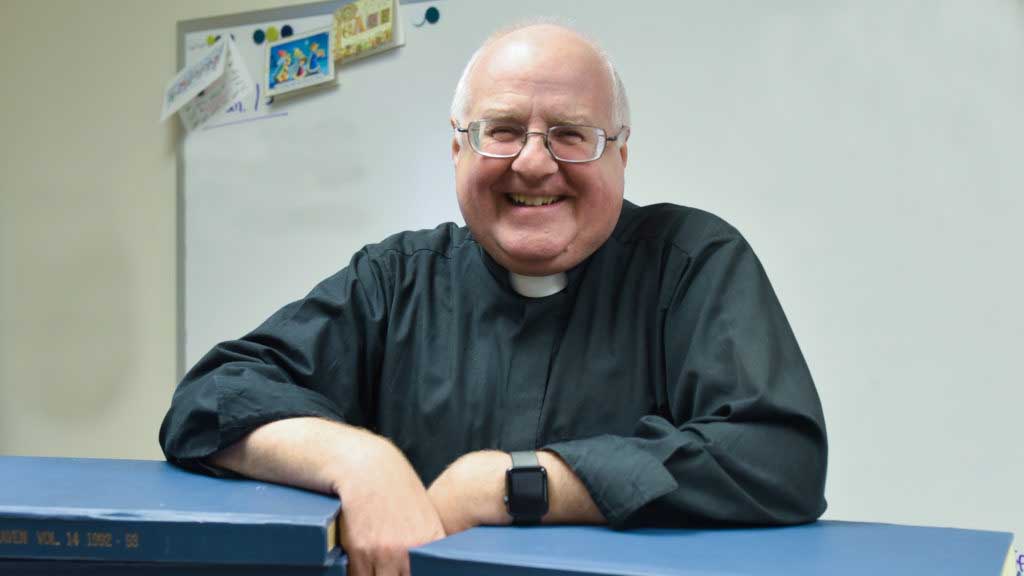
by Father Mark Goldasich
Eleven months.
That’s how long it’s been since I’ve worked at my Leaven desk. It was St. Patrick’s Day, and we’d just finished that week’s issue. The church offices were going into lockdown, we heard, as per state and county protocols.
We packed up the items that we’d need to work from home and jokingly said to one another, “Well, I’ll see you whenever!” — never imagining being gone for more than a couple of weeks.
There was nervousness as well. After all, we’d never actually put out a Leaven remotely. We thought we had all the pieces in place, but there were still questions. We were prepared to maybe put out one issue from home, anticipating a time some winter — like these past few days? — when we couldn’t physically make it into the office. At most, though, we were prepared to do just a few pages, to “finish things up.”
Oh, little did we know.
Just when you think that you have everything under control, life can throw you a curve. This story, written by Protestant theologian Jay Akkerman, reminds me of that:
From Sept. 26, 1991, until that same date in 1993, scientists sequestered themselves in an artificial environment called Biosphere 2. Inside their self-sustaining community, the Biospherians created a number of mini-environments, including a desert, rain forest and ocean. Nearly every weather condition could be simulated except one: wind.
Over time, the effects of their windless environment became apparent. For example, a number of acacia trees bent over and snapped. Without the stress of wind to strengthen the wood, the trunks grew weak and could not hold up their own weight. (Found in “1001 Illustrations That Connect,” edited by Craig Brian Larson and Phyllis Ten Elshof.)
The moral of the story? Though we humans shun hardship, God can use it for our good. It’s no accident that the Holy Spirit is often depicted as a driving wind. That godly breeze can not only change things, but make us stronger.
February is Catholic Press Month and I’d like to give a shout-out to my incredible, hardworking staff. The pandemic has disrupted how we normally produce the paper, but they’ve responded with resiliency and creativity. Not one issue of The Leaven was missed, even in the earliest days of the pandemic. I admit the first “remote” issue of The Leaven was a nail-biting time. But we’re still here to tell the tale.
I can’t do justice to list all of the behind-the-scene ways that the staff works, but here are a few highlights:
• Managing editor Anita McSorley is the oil that keeps all of the parts moving smoothly. Her organizational skills, ability to generate story ideas, collaboration with our freelancers, editing talents, love of journalism and knack for worrying are all invaluable.
• Production manager Todd Habiger is ever perfecting his designing skills, so the paper continues to have a fresh and inviting look. He’s also the one who assigns photographers and occasionally flexes his writing chops, especially on sports stories.
• Senior reporter Joe Bollig continues to generate story after story, particularly on complex topics like legislative issues. He has a talent for captivating “ledes” and a wicked sense of humor.
• Reporter Moira Cullings is not only a talented writer, but also our social media editor. Her knowledge and maintenance of all things internet are priceless, as is her patience with us web-impaired, older staff members.
• Advertising coordinator Beth Blankenship has done a masterful job of managing the office and keeping everything ad-related in order, especially during this uncertain pandemic time. She also produces the classified and calendar pages — a thankless task — and serves as our bookkeeper!
And what do I do? I’ve been furloughed from my primary role of interrupting the staff, especially on deadline day. My role now is to be the wind — some might dismissively say “hot air” — that keeps things stirred up!

